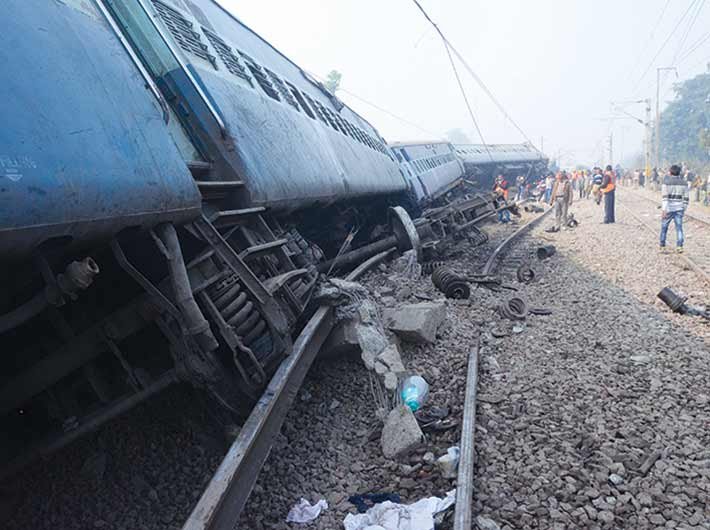Mishaps in the past have mocked the railways’ claim of introducing high-speed trains with no concrete safety plan in place
At a time when we are thrilled at the thought of the arrival of hyperloop transportation technology enabling high-speed travel inside a partially vacuum tube and introduction of the bullet trains, our conventional trains and the passenger safety are completely off the track.
The railway ministry is drawing criticism for failing to preventing derailment accidents that took place in the recent past. Three horrific accidents took place in little over two months. On November 20, 2016, the Indore-Patna Express derailed near Pukhrayan in Kanpur killing approximately 145 passengers and leaving several injured. The accident prompted railway minister Suresh Prabhu to hold marathon meetings with railway board officials to initiate strict action against lax officials and prevent any reoccurrence. However, barely after one-and-a-half month of the Pukhraya incident, 15 coaches of the Ajmer-Sealdah Express came off the tracks and crumpled into one another at Rura, nearly 70 km from Kanpur. This incident further escalated Prabhu’s tension. The latest accident took place on January 21, when the Hirakhand Express was derailed in Vizianagaram district of Andhra Pradesh, killing at least 41 people.
The accidents have exposed the railways’ inability to ensure accident-free operations. The mishaps triggered a debate over the need of initiating comprehensive safety measures and recruiting adequate staff for the safety wing. The railways which was hogging the limelight for being pro-active on social media addressing to passengers’ grievances and disseminate real-time rail information, is in the news for all the wrong reasons. Such fatal incidents have raised doubts over the railways’ intention of providing fast and safer travel experience.
In a hurriedly called meeting, Prabhu sought the help of experts from South Korea, Italy and France to ascertain reasons behind both the gruesome accidents. Sources said the railway minister did not want to give any chance to the opposition that launched scathing attack on the former for failing to curb major accidents. A team of experts from South Korea met senior railway officials along with railway board members at the Rail Bhavan on January 16 and visited Rura near Kanpur on the next day to assess the reasons behind the fatal mishap. The team would also visit Pukhraya in Kanpur dehat.

In 2011, a high-level safety review committee led by Dr Anil Kakodkar was constituted to go deep into the causes of rail mishaps and bring out safety recommendations to ensure accident-free operations. The committee submitted the report on February 17, 2012. However, the files kept gathering dust till February 2016 when it was finally accepted by the government to implement its suggestions.
The financial implication of the Kakodkar report is Rs 20,000 crore annually for five years, i.e., the railways would require at least Rs 1.20 lakh crore towards safety recommendations’ implementation for a period of five years.
The 160-page committee report came out with 106 recommendations covering aspects like safety issues, upgradation of signaling and telecommunications, recruitment of safety staff, plugging the shortage of critical safety spares, removal of encroachments and elimination of unmanned crossings. Out of 106 recommendations, 68 were fully accepted by the ministry while 19 were partially accepted. The ministry turned down to accept remaining 19 suggestions. So far, only 27 recommendations of the panel have been implemented till November 22, 2016.
The recommendations include filling of safety wing vacancies, introduction of video camera based data logging, storage and display in monitoring room of train examiners cabin, eviction of encroachments, and manufacturing of German LHB coaches in all the coach manufacturing units and phasing out of ICF design carriages among others. Senior officials, in an interaction with Governance Now, admit that the openings in the safety department can’t be filled overnight. They also estimated that it would take at least five to six years to completely eliminate unmanned level crossings across the country which is one of the prominent reasons behind rail mishaps.
“By implementing the recommendations alone will not solve the problem instead there is the need of improving tracks maintenance in the most congested routes,” an official who did not wish to be quoted said.
Sources said the distressed railway minister warned the zonal railways’ general managers to tighten their belts and take safety related works seriously or be ready to face the music.
A senior official went on to the extent of saying that it was the incumbent government which took the note of the safety committee report in 2014 whereas the UPA government kept “sitting” over it and did not implement the recommendations.
In a reply in the Rajya Sabha, the ministry said that as many as 327 train accidents occurred between 2014 and November 2016 in which 599 people lost their lives and 887 people sustained injuries. Another report on safety and security in the railways showed that 421 people lost their lives in 857 derailment accidents and 1,456 persons died as 610 mishaps took place at unmanned level crossings in the 11 years between 2005-06 and 2015-16.
The railway ministry briskly issued a circular to all of its zones on a month-long safety awareness campaign that began on January 5, 2017. It asked all general managers (GMs) and divisional railway managers (DRMs) of different zones and divisions respectively to conduct field inspections of at least one section during the campaign. It also directs senior officials to undertake night footplate inspections every night.
The railways requested the finance ministry on November 18, 2016 to sanction a non-lapsable ‘Rastriya Rail Sanraksha Kosh’ of Rs 1,19,183 crore. The railway ministry has planned to spend Rs1,11,683 crore towards safety improvement. The safety related works include track maintenance, bridge rehabilitation, level crossing work, replacement and improvement of signaling system, improvement and upgradation of rolling stock, replacement of electrical assets and human resource development.
Further, the railways needs Rs 43,444 crore for elimination of unmanned level crossings, construction of road over bridges, road under bridges and low height subways to prevent accidents at level crossings. For track works including the maintenance, the ministry requires Rs 30,032 crore.
In the 2015-16 budget speech, Prabhu had mentioned that over the next five years, the railways envisaged an investment of Rs 8.5 lakh crore including a whopping Rs 1.27 lakh crore for safety works including track renewal, bridge work, signaling and telecom.
“Unfortunately, railway facilities have not improved very substantially over the past few decades. Chronic underinvestment is one of the principal reasons which had led to congestion and over-utilisation. As a consequence, capacity augmentation suffers, safety is challenged and the quality of service delivery declines, leading to poor morale, reduced efficiency, sub-optimal freight and passenger traffic, and fewer financial resources. This again feeds the vicious cycle of under-investment,” Prabhu said in his 2015-16 budget.
Financial commissioner, ministry of railways, Shahzad Shah recently told Governance Now that the safety budget is increasing every year to ensure safe operations. “The ministry is committed to reduce major mishaps and ensure accident-free railways,” he remarked.
Sources said that Rs 39,200 crore were allocated to the ministry in 2013-14 towards safety works, Rs 42,304 in 2014-15, Rs 45,500 in 2015-16, Rs 57,227 crore in 2016-17. In the coming budget, the grant is likely to cross the figure of Rs 65,000 crore. “We are expecting that an additional grant of Rs 8,000-10,000 crore would be allocated by the finance ministry for track renewal, maintenance and construction of bridges under safety head,” an official said on condition of anonymity.
Former chairman railway board (CRB) Vivek Sahai said that the railways should give due attention to track renewal and maintenance to put an end to major fatal accidents. “Whatever funds are getting allocated by the government should be utilised for safety work,” Sahai remarked.
Of the 1,14,907 kms of total track length of railways, 4,500 kms of track should be renewed annually. However, because of lack of funds the work is constantly hampered for the past six years. Arrears of track renewal are accumulating which will result in disproportionately high maintenance effort.
“It is essential that safety is accorded topmost priority and concerted efforts are being taken to ensure ‘zero accidents’ as envisaged by the railway minister. The railways understands the need of revisiting safety issues and identify and attend all potential vulnerable areas in a comprehensive month-long drive to prevent further mishaps,” said railway ministry additional director general (public relations) Anil Saxena.
He further said that to ensure safer travel, more Linke Hofmann Busch (LHB) coaches are being manufactured by the coaching manufacturing units and within five to six years all conventional coaches will be replaced with German LHB carriages which are safer than the former.
As the railways is planning to pump in millions of dollars on creating infrastructure for the high-speed trains, it will be important to see how it will achieve its dream of “zero accidents” in the near future.
Meanwhile, on January 23 a major train accident was averted near Samastipur in Bihar after a patrolling staff of east central railway (ECR) spotted two stone slabs of around one metre placed over an up line track on minor bridge between Samastipur and Barauni. “As sabotage is also a factor which cannot be neglected, the intensive and extensive monitoring of track is also being done,” said ECR’s chief public relations officer Arvind Kumar Rajak
vishwas@governancenow.com
(The article appears in the February 1-15, 2017 issue)

